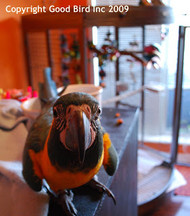When A Parrot Does Not Want To Go Back In Their Cage
Posted by Parrot Cage, Parrot Behaviour, Parrot Training on 9/1/2024
Barbara Heidenreich explains what to do if a Parrot doesn’t want to go back in their cage.
Jackson
Having a baby Blue Throated Macaw (Jackson) and baby Double Yellow Headed Amazon (Joker) Parrot in the house is fun. And apparently it is fun for them too. I like to think so as my house has a number of very entertaining play areas for Parrots. There is this super cool play stand, perches all around the house, and two training areas loaded with all sorts of toys and treats. You can buy play stands here, toys here and treats here.

So when the sun rises, the birds are ready to stretch their wings, participate in some training and play, play, play. This makes for a great morning for the birds, but at some point they do need to return to their cage for a little down time for everyone. This can be a challenge when being outside of the cage is such a blast. Why go back inside if all the fun happens outside?
When I felt one of the birds leaning back on my hand when I approached the cage one morning, I knew it was time to take action. If I forced the bird into the cage, I pretty much knew I was asking for trouble. What would happen is, in the future the birds would be even more hesitant to go back inside.
Training session
Instead we had a training session right then and there. As soon as I felt the lean, I stopped in my tracks and took a step back from the cage. When Jackson’s body language relaxed I gave him some head scratches for sitting calmly on my hand while we were close to the cage. Over time we were able to get closer and he even stepped on a perch in the cage for a treat. I then let him step right back on my hand and come back out.
We repeated this until he was back to stepping into the cage easily. He learned going in the cage doesn’t mean all the fun stops. I now also rotate different toys into the cage. So that every time he goes back there is a new toy to play with. This helps keep this behaviour strong.
Because this behaviour can be challenging, I know I will always be careful to look for body language that says the bird is uncomfortable. And if I see it I will slow down and go through these steps again. This will be important to helping to maintain that behaviour for the long haul. For now I’m also going to be sure to give myself plenty of time to return the birds to their cages, just in case I see any hesitation. I don’t want to have a set back by not planning ahead.
Buy cages here.
Contact details
Barbara Heidenreich
www.GoodBirdInc.com
This was originally published on Barbara’s blog in 2009.
For more information on training and behaviour please click here.

 African Grey
African Grey
 Amazon
Amazon
 Budgie
Budgie
 Caique
Caique
 Canary and Finch
Canary and Finch
 Cockatiel
Cockatiel
 Cockatoo
Cockatoo
 Conure - Large
Conure - Large
 Conure - Small
Conure - Small
 Eclectus
Eclectus
 Lovebird
Lovebird
 Macaw - Large
Macaw - Large
 Macaw - Small
Macaw - Small
 Meyer's and Senegal
Meyer's and Senegal
 Quaker
Quaker
 Kakariki
Kakariki
 Alexandrine
Alexandrine
 Avian Specific
Avian Specific
 Bird Systems
Bird Systems
 Manzanita
Manzanita
 Marriages
Marriages
 Mikey and Mia
Mikey and Mia
 Planet Pleasures
Planet Pleasures
 Psittacus
Psittacus
 Your Parrot
Your Parrot
 Arcadia Bird Lights
Arcadia Bird Lights
 Assorted Brands
Assorted Brands
 Aviator Harnesses
Aviator Harnesses
 Beaphar Bogena
Beaphar Bogena
 Bird Kabobs
Bird Kabobs
 Bird Street Bistro
Bird Street Bistro
 Birdie Bangles
Birdie Bangles
 Brown's
Brown's
 Bucktons
Bucktons
 Busy Bird
Busy Bird
 Jelly Cups
Jelly Cups
 Creative Foraging
Creative Foraging
 F10 Disinfectant
F10 Disinfectant
 Hari
Hari
 Harrison's
Harrison's
 Java
Java
 Johnsons
Johnsons
 Johnston and Jeff
Johnston and Jeff
 Kaytee Exact
Kaytee Exact
 King's
King's
 Lafeber NutriBerries
Lafeber NutriBerries
 Liberta 2nd Edition Parrot Cages
Liberta 2nd Edition Parrot Cages
 Liberta Cages
Liberta Cages
 Natures Instinct
Natures Instinct
 Northern Parrots
Northern Parrots
 Paradise Toys & Accessories
Paradise Toys & Accessories
 Parrot Cafe
Parrot Cafe
 Parrot Safe Candles
Parrot Safe Candles
 Polly's Natural
Polly's Natural
 Poop-Off
Poop-Off
 Pretty Bird
Pretty Bird
 Prevue Hendryx
Prevue Hendryx
 Rainforest Cages
Rainforest Cages
 Super Bird Creations
Super Bird Creations
 The Birdcare Company
The Birdcare Company
 TOP'S Parrot Food
TOP'S Parrot Food
 Versele-Laga
Versele-Laga
 Vetark
Vetark
 Vitakraft
Vitakraft
 Vitapol
Vitapol
 Xtra Vital
Xtra Vital
 Zoo-Max
Zoo-Max
 ZooMed
ZooMed
 ZuPreem
ZuPreem
